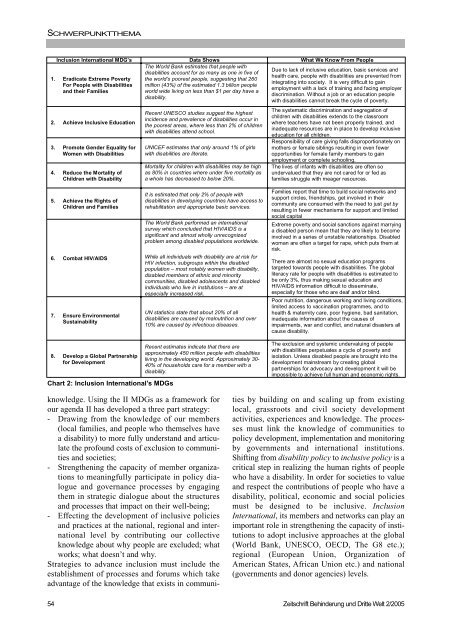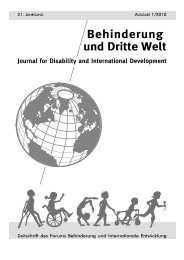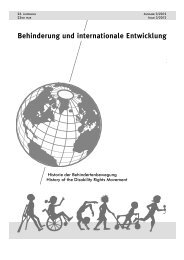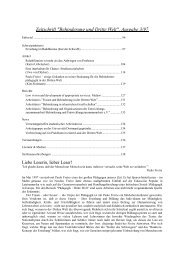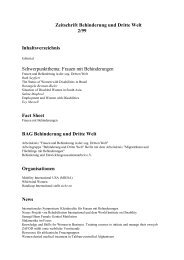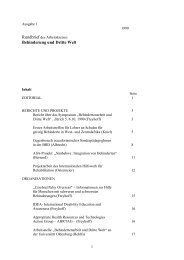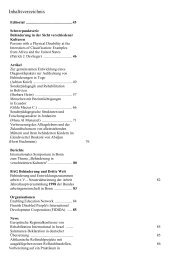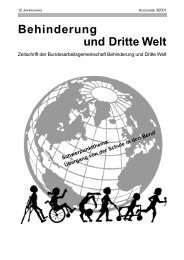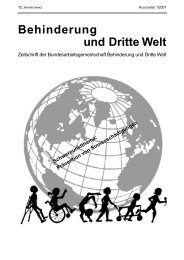Armut und Behinderung - Behinderung und Dritte Welt
Armut und Behinderung - Behinderung und Dritte Welt
Armut und Behinderung - Behinderung und Dritte Welt
You also want an ePaper? Increase the reach of your titles
YUMPU automatically turns print PDFs into web optimized ePapers that Google loves.
SCHWERPUNKTTHEMAInclusion International MDG’s Data Shows What We Know From PeopleThe World Bank estimates that people withDue to lack of inclusive education, basic services anddisabilities account for as many as one in five ofhealth care, people with disabilities are prevented from1. Eradicate Extreme Poverty the world’s poorest people, suggesting that 260integrating into society. It is very difficult to gainFor People with Disabilities million (43%) of the estimated 1.3 billion peopleemployment with a lack of training and facing employerand their Familiesworld wide living on less than $1 per day have adiscrimination. Without a job or an education peopledisability.with disabilities cannot break the cycle of poverty.2. Achieve Inclusive Education3. Promote Gender Equality forWomen with Disabilities4. Reduce the Mortality ofChildren with DisabilityRecent UNESCO studies suggest the highestincidence and prevalence of disabilities occur inthe poorest areas, where less than 2% of childrenwith disabilities attend school.UNICEF estimates that only aro<strong>und</strong> 1% of girlswith disabilities are literate.Mortality for children with disabilities may be highas 80% in countries where <strong>und</strong>er five mortality asa whole has decreased to below 20%.The systematic discrimination and segregation ofchildren with disabilities extends to the classroomwhere teachers have not been properly trained, andinadequate resources are in place to develop inclusiveeducation for all children.Responsibility of care giving falls disproportionately onmothers or female siblings resulting in even feweropportunities for female family members to gainemployment or complete schooling.The lives of infants with disabilities are often so<strong>und</strong>ervalued that they are not cared for or fed asfamilies struggle with meager resources.5. Achieve the Rights ofChildren and Families6. Combat HIV/AIDS7. Ensure EnvironmentalSustainabilityIt is estimated that only 2% of people withdisabilities in developing countries have access torehabilitation and appropriate basic services.The World Bank performed an internationalsurvey which concluded that HIV/AIDS is asignificant and almost wholly unrecognizedproblem among disabled populations worldwide.While all individuals with disability are at risk forHIV infection, subgroups within the disabledpopulation – most notably women with disability,disabled members of ethnic and minoritycommunities, disabled adolescents and disabledindividuals who live in institutions – are atespecially increased risk.UN statistics state that about 20% of alldisabilities are caused by malnutrition and over10% are caused by infectious diseases.Families report that time to build social networks andsupport circles, friendships, get involved in theircommunity are consumed with the need to just get byresulting in fewer mechanisms for support and limitedsocial capitalExtreme poverty and social sanctions against marryinga disabled person mean that they are likely to becomeinvolved in a series of unstable relationships. Disabledwoman are often a target for rape, which puts them atrisk.There are almost no sexual education programstargeted towards people with disabilities. The globalliteracy rate for people with disabilities is estimated tobe only 3%, thus making sexual education andHIV/AIDS information difficult to disseminate,especially for those who are deaf and/or blind.Poor nutrition, dangerous working and living conditions,limited access to vaccination programmes, and tohealth & maternity care, poor hygiene, bad sanitation,inadequate information about the causes ofimpairments, war and conflict, and natural disasters allcause disability.8. Develop a Global Partnershipfor DevelopmentChart 2: Inclusion International’s MDGsRecent estimates indicate that there areapproximately 450 million people with disabilitiesliving in the developing world. Approximately 30-40% of households care for a member with adisability.The exclusion and systemic <strong>und</strong>ervaluing of peoplewith disabilities perpetuates a cycle of poverty andisolation. Unless disabled people are brought into thedevelopment mainstream by creating globalpartnerships for advocacy and development it will beimpossible to achieve full human and economic rights.knowledge. Using the II MDGs as a framework forour agenda II has developed a three part strategy:- Drawing from the knowledge of our members(local families, and people who themselves havea disability) to more fully <strong>und</strong>erstand and articulatethe profo<strong>und</strong> costs of exclusion to communitiesand societies;- Strengthening the capacity of member organizationsto meaningfully participate in policy dialogueand governance processes by engagingthem in strategic dialogue about the structuresand processes that impact on their well-being;- Effecting the development of inclusive policiesand practices at the national, regional and internationallevel by contributing our collectiveknowledge about why people are excluded; whatworks; what doesn’t and why.Strategies to advance inclusion must include theestablishment of processes and forums which takeadvantage of the knowledge that exists in communitiesby building on and scaling up from existinglocal, grassroots and civil society developmentactivities, experiences and knowledge. The processesmust link the knowledge of communities topolicy development, implementation and monitoringby governments and international institutions.Shifting from disability policy to inclusive policy is acritical step in realizing the human rights of peoplewho have a disability. In order for societies to valueand respect the contributions of people who have adisability, political, economic and social policiesmust be designed to be inclusive. InclusionInternational, its members and networks can play animportant role in strengthening the capacity of institutionsto adopt inclusive approaches at the global(World Bank, UNESCO, OECD, The G8 etc.);regional (European Union, Organization ofAmerican States, African Union etc.) and national(governments and donor agencies) levels.54Zeitschrift <strong>Behinderung</strong> <strong>und</strong> <strong>Dritte</strong> <strong>Welt</strong> 2/2005


